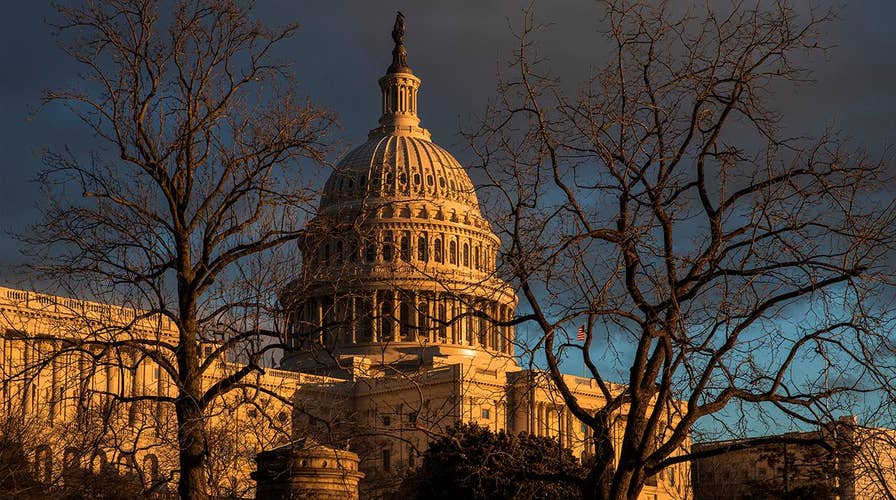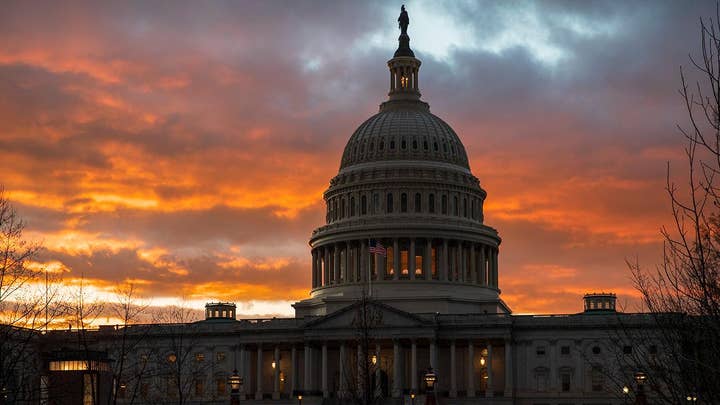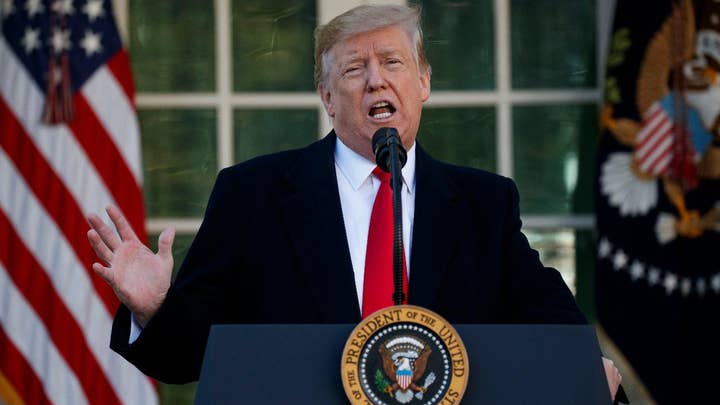The linchpin to avoiding another government shutdown in mid-February is a House-Senate conference committee on border security which publicly convenes Wednesday afternoon. Either the sides work out a deal or there is a serious risk of a government shutdown in a few weeks.
So, what is a conference committee?
A conference committee is a bipartisan, bicameral group of lawmakers appointed by leadership because of their expertise or areas of jurisdiction on a given issue based on committee assignments.
Here’s what usually what happens to prompt a conference committee: the House and Senate approve similar, but different versions of legislation. In other words, the House has a poodle and the Senate has a Labrador retriever. Both are canines. Put them together and you get a labradoodle. But it’s still a dog. The key here is similar but different bills from the House and Senate. The House can’t offer the Homeland Security Appropriations bill and the Senate comes over with legislation about tribal fishing rights from the Committee on Indian Affairs. It doesn’t work that way. It would be like the House producing horse and the Senate coming up with cow. They don’t mix. But if both the House and Senate produce a dog breed, then they can go to a conference committee.
Think of the conference committee as a Congressional Cuisinart. The “conferees” (members of the conference committee) are expected to take all of their different ideas about border security – walls, drones, agents, border crossings, digital frontiers, you name it – and dump all of the ingredients into the blender. Hopefully when they get done mixing everything together, the sides have produced a singular, unified House-Senate bill. This legislation is called a “conference report.” Once approved in the conference committee, the House and Senate then take the conference report back to their respective bodies for adoption. If the full House and Senate approve the conference report, then the House and Senate are in sync. Both chambers have a single, synthesized bill which they can send to the President for signature.
The alternative option to a conference committee is something rhetorically referred to on Capitol Hill as “Ping-Pong.” This is where the House (or Senate) approves a bill and “pings” it over to the Senate (or House). Then the Senate makes changes on the floor, passes the revamped version and “pongs” it back to the House. The sides continue to knock the bill back and forth until one body or the other finally accepts the version from the other.
From a parliamentary standpoint, Congressional “Ping Pong” is known as a “message between houses.” But it doesn’t sound nearly as fun.
In this case, the House and Senate approved an interim spending bill (the Continuing Resolution, or CR) which is a stopgap bill to re-open the government last week. The CR covered all seven outstanding spending bills. However, the House and Senate agreed to “go to conference” on the lone bill which is seemingly intractable: funding for the Department of Homeland Security.
In its purist form, a conference committee is done in the open, with give and take between members. There are proposed amendments and changes. The conferees vote on the amendments and shape the final product. A good example of this was the conference committee which produced the Dodd-Frank financial legislation in 2010.
In its most banal form, the conference committee looks like a glorified press conference.
We expect the border security conference committee to resemble the latter. One public meeting with a bunch of boilerplate read out loud … and then offstage work over the next couple of weeks.
Here’s what Wednesday looks like:
In this instance, the House is the lead of the conference committee. House Appropriations Committee Chairwoman Nita Lowey, D-N.Y., will chair the conference committee. We expect opening statements (of four minutes apiece) from Lowey, Senate Appropriations Committee Chairman Richard Shelby, R-Ala., Rep. Kay Granger, R-Texas, the top Republican on the House Appropriations Committee and Sen. Leahy, D-Vt., the top Democrat on the Senate Appropriations Committee.
Then it’s on to the chairs and ranking members of the House and Senate Homeland Security Appropriations Subcommittees. Two-minute statements from Rep. Lucille Roybal-Allard, D-Ca., Sen. Shelley Moore Capito, R-W.Va., Rep. Chuck Fleischmann, R-Tenn., and Sen. Jon Tester, D-Mont.
Then, on to the remaining members of the conference committee, alternating between House Democrat, Senate Republican, House Republican, Senate Democrat.
Then the public session adjourns and the hard work begins behind the scenes.
There have been lots of questions about the “scope” of the conference committee. In other words, could the conferees start to wander away from “border security” (dog) and want to include something like the debt ceiling (cat) in the bill?
Maybe. The Senate has rules where issues must meet a test of germaneness. But there is precedent for a broad consideration of “outside” issues. We’ve heard rattling around about the inclusion of DACA or immigration reform. But Fox News is told by multiple sources on both sides of the Capitol that there is simply not enough time to mess with those nettlesome issues in this conference committee.
Senate Majority Leader Mitch McConnell, R-Ky., signaled he was for “whatever works.” But House Majority Leader Steny Hoyer, D-Md., indicated he didn’t expect DACA and immigration “to be part of the negotiation.”
“Taking a complex issue which caused a 35 day shutdown and then combining it with another complex issue like immigration which the sides have never been able to agree on and resolving it magically here just won’t happen,” said one senior congressional aide. “That would be a recipe for failure.”
In other words, keep it narrow.
OPINION: TRUMP ECONOMY IS SUCCESS STORY NOT EVEN HIS HARSHEST CRITICS CAN DENY
But…
It is generally thought that the House and Senate will only address the Homeland Security spending measure in this conference. However, it’s possible they could re-open the other six spending bills if that’s a way to forge a broad agreement. Hypothetically, House Democrats could ask for more spending in an area outside of DHS to meet their priorities – in exchange for GOP increases in border security.
Also, keep in mind that sequestration (the set of mandatory spending caps agreed upon in 2011) still apply. Lawmakers themselves would have to declare an “emergency” (different from President Trump declaring a national emergency for border security) to blow out the spending caps. Multiple sources on both sides of the aisle say that even though the president wants $5.7 billion for a wall, appropriators would have to cut other priorities in this bill. That would genuinely risk U.S. security. That is, unless, the sides agree to designate wall money as “emergency spending” and bust the sequestration caps.
In other words, that ain’t happening…
Here is the most significant problem facing the entire operation: time.
You will read the following nowhere else:
February 15 may be the concrete deadline to fund the government. But in fact the true deadline to work this out is much, much earlier. The House now has a full, 72 hour rule to post the text of legislation before consideration. So the REAL deadline here is Friday, February 8. Maybe Sunday, February 10. That would give the House just enough time to turn the bill around and pass it quickly, observing the three-day marker. Keep in mind, the measure must still go to the Senate.
Time could snatch defeat from the jaws of victory here.
“I’m not expecting a lot from this conference committee,” said one senior source.
Here’s another big question: what does House Speaker Nancy Pelosi, D-Calif., want? What is acceptable to House Democrats? That is unclear. Fox News is told the key Democratic ideals in the conference committee will emanate from an alternative border security bill which Democrats worked on in private during the shutdown – but never released.
There are two key players to watch on the conference committee:
Keep one eye on Sen. Roy Blunt, R-Mo., and the other on Rep. Barbara Lee, D-Calif. Blunt is an old-style dealmaker. He has a good rapport on both sides of the Capitol and both sides of the aisle. Lee is a close ally of Pelosi. She just lost the race in November to Rep. Hakeem Jeffries, D-N.Y., to chair the House Democratic Caucus. Lee is an appropriator. It is thought her assignment to the conference committee could be a bit of a consolation prize for losing the leadership race. But Lee could serve as the speaker’s ear in the conference. Lee is also a liberal Democrat who will oppose anything close to a wall. If the Democrats truly don’t want a deal and want Trump to squirm, watch Lee.
Here are some touchstone issues in the conference committee:
There will be debates about humanitarian assistance, land ports of entry, personnel, additional Customs & Border Patrol (CBP) Agents, additional Immigration and Customs Enforcement (ICE) agents, and, additional ICE beds. Democrats will raise hackles over demands for additional ICE personnel and ICE beds. Those issues are likely dead.
CLICK HERE TO GET THE FOX NEWS APP
If there is an agreement and the sides ink a final conference report, don’t expect the words “wall” to necessarily appear anywhere in the legislation. It was said that the government shutdown was all about semantics. Well, if the conference committee produces a comprehensive agreement, Republicans will trumpet key text as a “wall.” Democrats will hail “border security.”
If that’s the case, everyone will be happy because they can declare victory.








